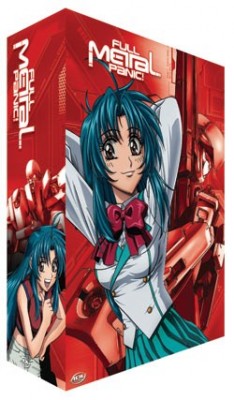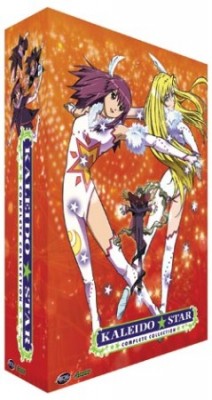
 |
|
| |||||||||||
|
Initial D, DIrty Pair, and Naruto
AnimeTalk November 2010 Edition by Todd
Douglass, John Sinnott, Bobby Cooper, and Wen-Tsai Hello and welcome to Anime Talk once again! We've been busy this past month with reviews of anime and manga and hey, we thought we'd share them with you! Granted we don't have too many anime titles to feature this time around, but we compensate for that with plenty of manga reviews. In this column you'll find some sweet new stuff and classic titles as well. On the classic front we have the likes of Trigun and Dirty Pair to feature and on the new side of that coin we saw another Hetalia and Canaan as well. Here you'll also find some of our suggestions for holiday shopping. 'Tis the season after all. To that end, WTK is here to help you by sharing some really good bargains. He's basically your ticket out of a coal-full of stocking. Be nice to him, not Santa, and I'm sure some awesome anime will appear under your tree this year!
The
Latest Anime Reviews:
You don't have to be a gear-head to enjoy the intense racing action in Initial D: First Stage, Part One. The story centers on Takumi, a prodigal drift racer who speeds down mountain roads while delivering tofu for his father's store. The only problem is that Takumi does not enjoy racing and barely knows more about cars than the average Joe who frequents Jiffy Lube every 3,000 miles. As the series progresses, Takumi develops a passion and competitive spirit that he never knew existed within him. This older series is surprisingly entertaining and will capture your imagination, regardless of your automobile IQ. Anime series like Eden of the East do not come around very often, so if you haven't seen it yet, stop reading and find this set. On a graduation trip to Washington D.C., Saki Morimi meets Akira, a strange man her own age with no recollection of his past. Oh, and he's running around the national monuments naked. They head back to Japan where Akira discovers that he is an unwilling participant in a bizarre game where the goal is to save Japan. To divulge any more of the story rather than let you experience it would be an unforgiveable sin. This series has it all: likeable characters, an intricately crafted plot, tons of action, and more laughs than you might expect. Not a moment is wasted in this deep and mysterious story that never stops building until the very end and leaves you pining for more. The ending does not wrap things nicely--the story stops more than it ends. Thankfully, there are two movies being released that should clear up any remaining loose ends. Eden of the East is one those rare series that will appeal even to non-anime fans and should fit comfortably on everyone's Must-See list.
The next classic show on our plate this month was Dirty Pair, released by Nozomi Entertainment/RightStuf!. This classic series has definitely been around the block a few times in its 25 year existence, but every once in a while it's nice to get back to basics and explore the roots of anime fandom. This was one of those early shows that really grabbed my attention and drew me into the industry, but then again by the time I saw it I was a teenager. You do the math. Two girls running around in their underwear fighting crime. Yeah, it's not rocket science. But it's fun and that's what counts! And finally, we have the other new show that's making headlines, Hetalia: Axis Powers. This twisted little show has been tearing up the charts and with good reason. Take the nations of the world and present them in the form of a single character. Now put those characters in the situation of world history and events like World War II, and you have endless possibilities. Whacky humor, insane personality, and a whole bunch of charm are crammed into this series and the second season keeps being awesome.




 For more anime bargains, please check out the monthly Official- ANIME Bargains! - Thread, updated by yours truly! Please Note: Product Availability & Prices are Subjected to Change! Updated on 11/14/2010! by Todd Douglass and Bobby Cooper
One thing keeping Haruhiko going is the fact that he just landed another part-time job at a café. It doesn't bring in much money, but it's enough to get by. This also gives us the opportunity to meet Jun-chan, a tsundere character archetype with an explosive attitude and distaste for men in general. Lucky for our protagonist he has a childhood friend, Yuriko, who tags along to help, and one of the maids, Nanako, from his mansion even comes to live with and take care of him. See a pattern developing here? The first volume of the manga goes through the motions of introducing all the main players and giving readers plenty of opportunity to see the female cast in skimpy garb. Panty shots, lingerie picks, wet t-shirts, and plenty of provocative poses are used as gimmicks here. Many of these stem from Haruhiko's fantasies, but some come from stereotypical situations such as the guy walking in on the girl, accidentally grabbing her chest, or catching a glimpse of undergarments. The bits that are supposed to be funny generally are in terms of what's unique to the series. Seeing Haruhiko go to lengths to save loose change is kind of amusing, and seeing Nanako piece together haphazard quick fixes is definitely a highlight. Really the main draw for the book at this point is the awkward situations its protagonist finds himself in and the nicely drawn fan-service by Kaneda. At this point the series doesn't offer a hook. The characters are entertaining, but there's a stereotypical element to their relationships. The fan-service gags never feel fresh and even then what's here is relatively tame, even in comparison to Girls Bravo. Fans of that series will want to pick this up because the tone of the book is fairly similar, however, anyone looking for true laughs or something original will be left wanting. For now I'm going with a very light recommendation for this one, and would go as far as to say you're probably better off checking it out in a bookstore before blind buying it.
Set in an alternate timeline where Ayakami (powerful spirits) plague the land, there exists an underground collection of exorcists who utilize shikigami (other spirits) to protect the world. It's a straightforward and familiar concept that has been applied before in both manga and anime. In the case of Summoner Girl, however, Kubota has infused the magical girl element as well. Hibiki is a fourth grade girl who has risen in rank among exorcists, mostly thanks to some assistants from her militant grandmother. She has been bestowed with five shikigami, who each represent various elements in the world, and has been charged with tracking down six magical jewels named Rikutou. Along the way the book introduces Kenta Oda, a young boy from a nearby temple, and a rival for Hibiki who is big on personality, but is yet unnamed. The pacing for this first volume is rather formulaic with three chapters featuring three different stories. In each Hibiki comes into a situation and has to use her shikigami to get out of it. Rather than use brute strength, however, she looks for a peaceful solution and often attempts to win her opponents over rather than conquer them. This gives the series a lighthearted feeling that fits in with the cute artwork quite nicely. Even better is the overall sense of humor and style. Summoner Girl's first volume was a fun read. Hibiki is a charmer if there ever was one, though it does leave her feeling a little generic. The shikigami really take the center stage as they each bring their outlandish personalities to play during each and every conversation. They also speak through Hibiki when they possess her and the intermixing of personalities is quite interesting. Hibiki's grandmother is a nutcase and Kenta's energetic ignorance provides plenty of laughs. Ultimately this is a series that looks like it's going to be quite entertaining. I'm not certain how many volumes of the manga are released in Japan at this point, but it's got the set up for a long run. With that being said it also looks like the kind of book that could grow a little stale after a while. The formulaic storylines and generic plot disappoint, though the personality far outweighs any drawbacks. This first volume is recommended.
Bearing that in mind, there's undoubtedly a few of you out there that don't know anything about the series. After all, it still isn't "officially" released in America yet so there's a good chance many of you don't know about it. Basically, all you need to know is that it's a manga about nothing, essentially. It's the moe anime equivalent to Seinfeld where hardly anything happens in each chapter. The manga follows the story of a group of school girls who go on to form a pop music club. They become friends, learn how to play instruments, and well...that's basically it. The story here really is just about the girls and their relationships. The characters are Tsumugi (also known as Mugi), Ritsu, Mio (my personal favorite), and Yui. Ritsu is the go-getter and the driving force for much of the manga's antics. Mio is a close second and is often portrayed as the reserved quiet one. Mugi is arguably the most adorable and Yui is virtually drafted into the club against her will. The manga gets started quickly with the introduction of all the characters and the building of the club. The 4-koma does a great job in each panel of setting up the punch line and delivering on the laughs. Every one of the 121 pages of this manga is loaded with laugh out loud of kawaii moments that will win you over. Whether it's watching Yui get accustomed to owning a guitar, seeing Mio dolled up in a maid outfit, or witnessing the girl's first performance; this book is a charmer. Yen Press has a hit on their hands and I'd heartily recommend this book to anyone and everyone. It's funny, charming, and so damn adorable. This franchise has already shown it has staying power, and from my first taste it's easy to see why. I loved every bit of it and absolutely can't wait for the second installment! Highly Recommended
If you're unfamiliar with Spice & Wolf please feel free to visit my reviews of the first and second manga before reading through this review for the third installment. There may/will be some spoiler material ahead for those of you who are new to the series. I'm also going to direct you to those reviews as a way to provide background on the series, rather than recapping or reposting information. With that in mind, let's get on with the review of the third manga, shall we? This installment picks up with Holo and Lawrence on the run from the Medio Company and the Church. If you recall, the pair got caught up in a scheme to introduce a new form of currency that would devalue what was currently on the market. This was enough to put a price on their head. Making matters worse was the fact that the Church wanted to get its hands on Holo because she was considered to be a demon. Well, after a daring rescue Lawrence and Holo flee beneath the city into a maze of ancient tunnels and aqueducts. At every turn they bump into their pursuers and eventually they are left cornered with nowhere to run. Lawrence is wounded and losing a lot of blood, and the only hope for their escape is for Holo to reveal her true form and kick some ass. This creates something of a rift in their relationship, but it's also the opportunity for a new beginning. It's around the halfway point where things start to get interesting after their flight, but I won't divulge how things transpire. All I'm going to say as far as details of the book are concerned is that in the latter half a shepherd named Norah is introduced. This was a nice addition to the anime when it occurred and I look forward to reliving it through the manga as well. The third volume of Spice & Wolf continues to charm. The action in the first half is fast paced with some outstanding moments and a nice climax at the end of that particular storyline. From that point the book slips into its talk of economics and business for a while before building upon the characters even further. The artwork continues to be amazing and the translation of the text is appropriately diverse and flowery. The manner with which the characters speak has been a real draw for me, and I'm pleased to see that it is a tradition that continues. The book has miniscule course language and some light nudity (oh, that Holo), but really it's nothing graphic or adult. I suppose I should say don't let the "M" rating fool you. It's not ecchi or something like Queen's Blade, but rather the content is handled with class. It's all good in my opinion and I continue to be infatuated with this series. I can't get enough of Spice & Wolf and once you let Holo sink her teeth into you, you'll be hooked as well! Highly Recommended
Daniel X is not your average, ordinary high school student. His parents were alien hunters who were slaughtered right in front of him when he was just three-years-old. Not unlike Batman, this event inspires Daniel to someday avenge his parents. The story skips to where where he is 15-years-old and following in his parents' footsteps by actively protecting Earth from aliens who want to conquer our planet. Not much about Daniel X is original. Daniel's powers such as telepathy, transformation, and creation are described as his ability to manipulate the universal force. I suppose when you are deriving from an idea as embedded in pop-culture as The Force from Star Wars, there's no real point in shying away from it. Patterson's main storyline about aliens living among us, actively trying to conquer Earth, only to be held in check by secret "Alien Hunters" is obviously inspired by the Men In Black movies. Daniel can somehow manipulate subatomic particles and create things and even people. The solitary teenager creates a family of his own as well as a group of four close friends. The individuals that Daniel creates each, presumably, have their own personality and free will. In a strange twist, one of his creations, Dana, is his dream girl. Daniel eventually receives instructions to pack his things and head for Malibu, California--he's on a hunt for Seth, the #6 bad guy on the Top 10 Deadliest Aliens on Earth list. Upon reaching his destination, Daniel attends a local high school where he meets Phoebe, a cute, shy-ish new girl who is actually interested in him. Daniel uses his telepathic abilities to get a bead on how to talk to her and suddenly he finds himself questioning whether he should focus his attention on a real girl or stay on Dana. From here, Daniel must investigate the whereabouts of Seth and find a way to rescue the children that he has kidnapped. Seung-Hui Kye's artwork in Daniel X is exceptional, featuring fine detail where appropriate. Daniel's facial expressions and body language exude goodness with the type of loneliness that would lead someone to create friends and family. Daniel's clique of manufactured friends, outside of Dana, are artistically uninspired. However, the other characters, especially the villains, look fantastic. Kye's action scenes are easy to follow and page-turning fun. The final battle between Daniel and Seth is an exciting, well-imagined conclusion. Daniel X is a highly derivative sci-fi work with some manga hallmarks thrown in for good measure, but that doesn't mean it's worthless. The story of a high school student that must save the planet is hardly new to the world of anime/manga. The tight execution of the Daniel X's story, however, separates it from manga's crowded sci-fi subgenre. The plot seems rather ordinary at first, setting the stage for a "monster of the week" series. That is, until, Daniel is taken prisoner and transported to another planet where some loose plot threads begin to come together. The people he meets and the events that occur on this planet imply that the Daniel X universe is vast and brimming with a rich and fascinating history. I have never read James Patterson's Daniel X novels, but this manga book had me entertaining the thought of picking up a book or two just to see where this is heading. Daniel X is a little Star Wars, a lot of Men In Black, a dash of Batman, and a few sprinkles of any number of manga stories Shake N' Baked to juicy perfection. The result is not wholly original or unique, but still somehow delicious. If derivative works offend you, then Daniel X will have you cursing James Patterson's very existence. But if you can just kick back and enjoy a well produced sci-fi tale, then this first volume of Daniel X is worth a shot. I'll definitely come back for seconds and hopefully thirds with this series.
Editors from various shojo magazines contribute to this beginner's manual to drawing manga. I'm not sure where this book fits on an artist's bookshelf. The chapters touch on actual drawing so briefly that the authors must assume you have received extensive art instruction from other sources. The authors could not possibly expect an artist to learn from instructions that basically say, "Here's how a face looks. Practice makes perfect!" How to Draw Shojo Manga briefly touches on topics such as perspective, storyboarding, paneling, layout, inking, dialogue, lettering and even how to handle criticism. There is also a very useful, short, bonus chapter for producing manga digitally that gives some pointers on using scanners, tablets, and Manga Studio. While the chapters are almost laughably short, the book includes excellent listings of materials to buy for producing both traditional and digital manga art. There are a few tidbits here and there, such as font sizes to use while lettering, panel styles, and camera angles, that are useful and easy to locate within the small book. It is useful for new artists to see all the steps involved in creating a manga comic from inception to final product. Along with the instruction, the book includes a small side-story about Ena, an aspiring mangaka whose mission in life is to submit an entry for a manga contest. The sequences showing her frustrations as she learns the technique discussed in the chapter, messes up, crumbles her sheet of paper and starts over again are amusing; these scenes keep the book light in tone while emphasizing the take-home points. Ena's progress as an artist is nothing short of miraculous. She goes from a complete newb to rendering a beautiful shojo contest submission with only 132 pages of light instruction. If only I were as talented as Ena. The writers of this book encourage young artists to simply keep drawing. As time progresses, they claim, you will eventually improve to a professional level. That method may very well work for some. However, the writers fail to stress that there is no sure path to become a mangaka; simply drawing manga endlessly, without instruction or critique, is a perfect recipe to introduce bad habits that are difficult to break. Think Rob Liefeld, the infamous American comic artist who somehow achieved success in the 1990's, but still to this day cannot draw a foot. The advice in this book reminds me of many workshops at anime conventions where young artists bitterly grumble about their art teachers who do not respect manga as an art form or help them learn to draw comics. While some art teachers' condescending attitudes towards sequential art may be unfortunate, they are probably not out to dash your dreams; instead they simply want to help you become a better artist. Their argument is to learn to draw first. Learn how to draw what you see. Then, learn how to draw the human body in any pose and from any angle with proper proportions, expressions, and shading. Once you have the fundamentals down, use that knowledge to branch off into your own unique style. Young mangaka still perfecting their craft may want to seek materials that will help them actually learn to draw, such as the invaluable Vilppu Drawing Manuals, rather than drawing that one same, quarter-turned, manga-style face 1,000 times over. Learn to draw and don't be Rob Liefeld. I'm just here to help. How to Draw Shojo Manga is a high-level survey about producing a manga comic. Entire books have been written on many of the topics that just briefly mentioned on single pages. This book is aimed at teenage aspiring artists that are interested in creating manga, but have no idea where to start and what steps are involved. Many useful tidbits are scattered throughout the book, but this is an entry-level pamphlet for aspiring artists to outline what topics they will need to study further. Look at the chapter or "step" listing and plan on purchasing good, in-depth books on each one.
What do you think about the column? Like what you see? Don't
like it? Have a comment or suggestion? Drop us an e-mail
and let us know!
Archives
January 2015 Edition
2013 Q4 Top Anime Titles from RightStuf.com, Part 1 Holiday Edition Crunchy Roll, Lupin, and Bunny Drop Compete Archives
Review Staff
| Newsletter Subscribe
| Join DVD Talk Forum
|
| |||||||||
| |||||||||||